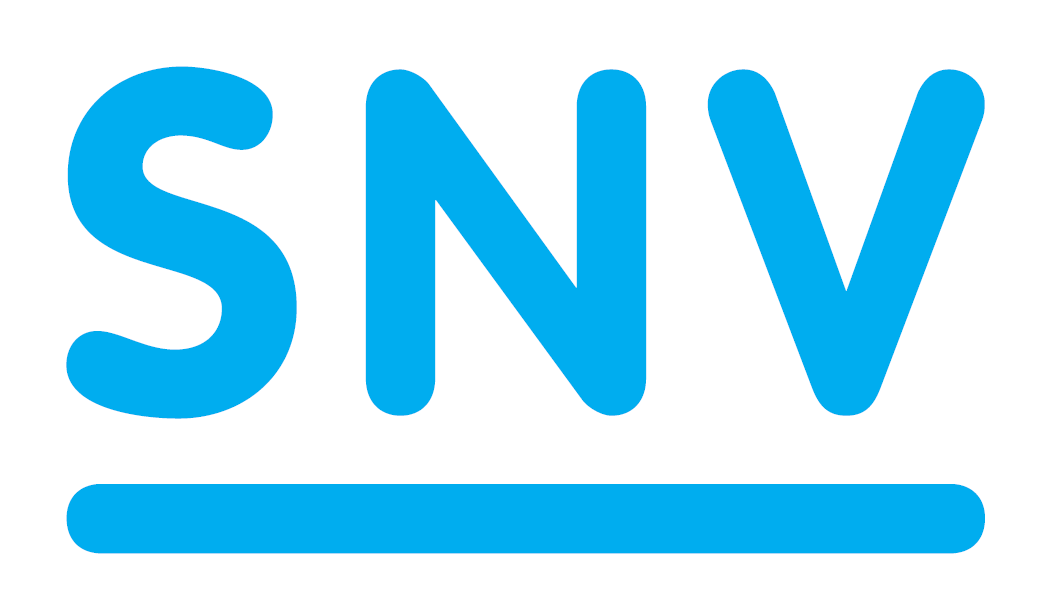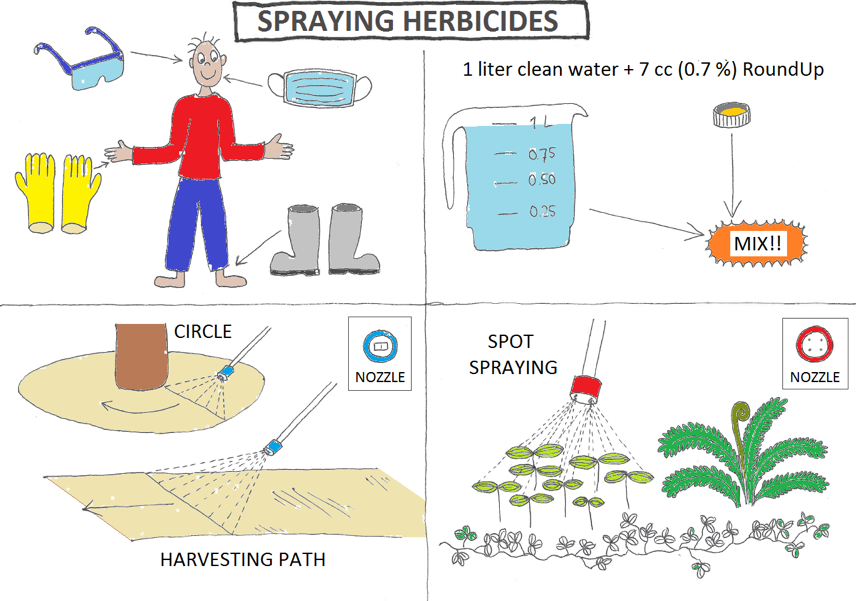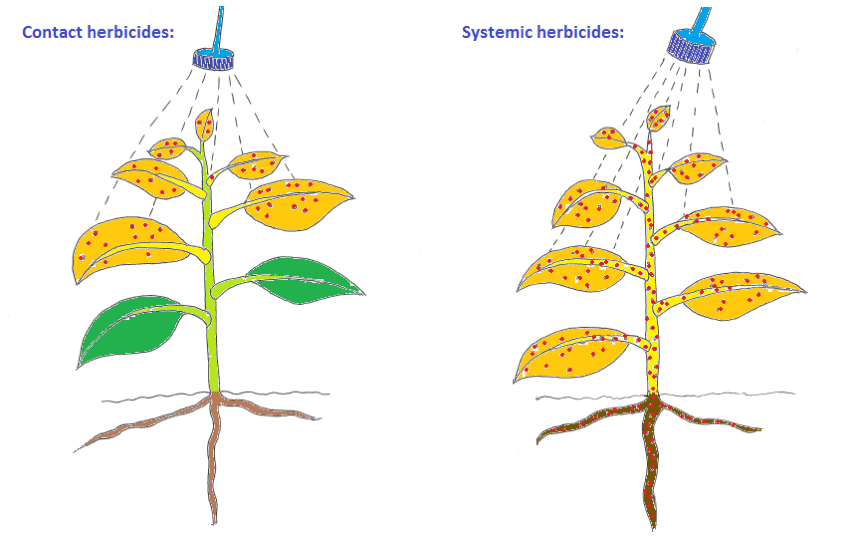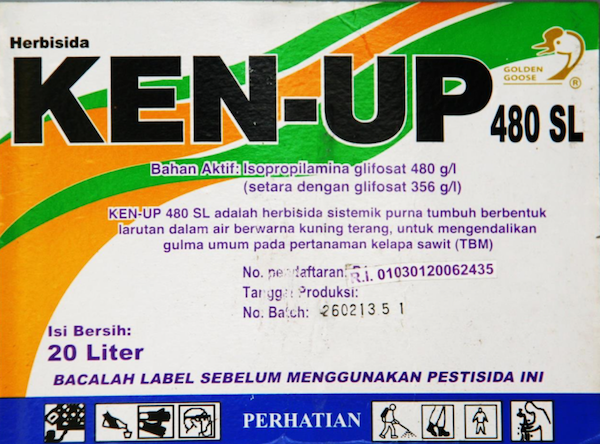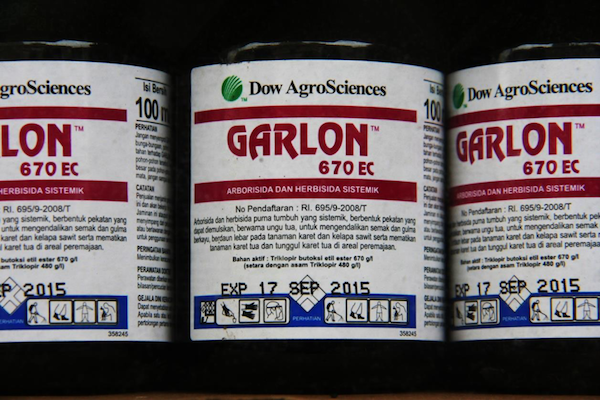Difference between revisions of "Budidaya Kelapa Sawit Berkelanjutan / Cara penyimpanan dan penyemprotan chemis"
Khukuh.ayuda (talk | contribs) (Created page with "link=http://www.snv.org/ link=http://www.wageningenur.nl/en/wageningen-university.htm Download:...") |
Khukuh.ayuda (talk | contribs) (Translation to Bahasa Indonesia on process) (Tag: Visual edit) |
||
| Line 2: | Line 2: | ||
[[Image:wageningen small.png|right|100px|link=http://www.wageningenur.nl/en/wageningen-university.htm]] | [[Image:wageningen small.png|right|100px|link=http://www.wageningenur.nl/en/wageningen-university.htm]] | ||
| − | + | Unduh: [http://intothefield.nl/wp-content/uploads/2016/05/Module-3-3rd-edition-2016-08.pdf Modul 3: Pemeliharaan Perkebunan] | |
{|style="background-color: #ffff7f" width="80%" cellpadding="15" | {|style="background-color: #ffff7f" width="80%" cellpadding="15" | ||
| − | |''' | + | |'''Perhatian!''' Herbisida, pestisida, dan bahan kimia lainnya sebagian besar beracun bagi manusia, hewan, dan kelapa sawit, dan digunakan secukupnya dan dengan hati-hati. |
| − | * | + | * Penggunaan chemis harus selalu dilakukan dengan menggunakan pakaian pelindung penuh (lihat [http://akvopedia.org/sandbox/File:Oil-palm-3.2-figure7.png Gambar 7]) termasuk: |
| − | :: - | + | :: - Sarung tangan karet |
| − | :: - | + | :: - Sepatu boot |
| − | :: - | + | :: - Masker gas atau pelindung pernapasan |
| − | :: - | + | :: - Kacamata pelindung |
| − | :: - | + | :: - Celemek berbahan karet |
| − | * | + | * Sangat disarankan bahwa kegiatan penyemprotan hanya dilakukan oleh pekerja yang pernah mengikuti sesi pelatihan |
| − | * | + | * Peralatan semprot harus selalu dalam kondisi bersih dan layak pakai |
| − | * | + | * Labeli / beri tanda setiap kontainer bahan kimia untuk menginformasikan isinya (contoh: herbisida (sebutkan namanya), pestisida (sebutkan namanya), dan sebagainya) |
| − | * | + | * Ketika menyiapkan bahan kimia tertentu, selalu ikuti petunjuk pemakaiannya pada kemasan |
| − | ''' | + | '''Jangan''' pernah menyimpan makanan dalam kontainer yang pernah digunakan untuk menyimpan bahan kimia atau pupuk. |
|} | |} | ||
| − | === | + | ===Menggunakan alat semprot panggul (knapsack) <ref>P. Griffee, P. Diemer, C. Chinchilla, Smallholder Oil Palm Manual, in, FAO, Rome, Italy, 2004.</ref><sup>,</sup> <ref name=knapsack>Stewardship Community, 2008, Knapsack spraying: best practices, http://www.stewardshipcommunity.com/best-spraying-practices/knapsack-spraying/knapsack-spraying-best-practice.html, Accessed September 2013.</ref>=== |
| − | [[Image:oil-palm-3.2-figure7.png|thumb | + | [[Image:oil-palm-3.2-figure7.png|thumb|200px|Gambar 7: Penggunaan pakaian pelindung yang layak untuk kegiatan penyemprotan herbisida (namun sarung tangan kiri tidak dipakai).]] |
| − | [[Image:oil-palm-3.2-figure8.png|thumb | + | [[Image:oil-palm-3.2-figure8.png|thumb|200px|Gambar 8: Alat semprot panggul yang biasa digunakan (diadaptasi dari <ref name=knapsack/>)]] |
| − | + | Alat semprot panggul yang umumnya digunakan adalah yang biasa disebut ‘alat semprot panggul dengan sistem tuas’ (lihat [http://akvopedia.org/sandbox/File:Oil-palm-3.2-figure8.png Gambar 8]). Saat menggunakan alat semprot panggul, pastikan untuk mengikuti langkah-langkah berikut ini: | |
{| style="border: 1px solid #72CDFF" cellpadding="5" cellspacing="0" | {| style="border: 1px solid #72CDFF" cellpadding="5" cellspacing="0" | ||
| − | |width="15%" valign="top"|''' | + | |width="15%" valign="top"|'''Langkah 1.''' |
| − | | | + | |Baca aturan penggunaan dengan seksama sebelum menggunakan alat. |
|- | |- | ||
| − | |width="15%" valign="top" style="background:#f0f8ff;" |''' | + | |width="15%" valign="top" style="background:#f0f8ff;" |'''Langkah 2.''' |
| − | |style="background:#f0f8ff;" | | + | |style="background:#f0f8ff;" |Sebelum mencampur dengan herbisida, periksa kelayakan alat semprot dengan mengisinya terlebih dahulu dengan air untuk memastikan alat tersebut berfungsi layak dan tidak ada kebocoran. |
|- | |- | ||
| − | |width="15%" valign="top"|''' | + | |width="15%" valign="top"|'''Langkah 3.''' |
| − | | | + | |Pilih mulut pipa (nosel) yang benar. Nosel adalah bagian dari alat dimana cairan herbisida akan disemprotkan keluar. Tipe dari nosel yang digunakan akan menentukan seberapa banyak semprotan cairan yang dikeluarkan dan seberapa luas lingkup semprotannya. |
|- | |- | ||
| − | |width="15%" valign="top" style="background:#f0f8ff;" |''' | + | |width="15%" valign="top" style="background:#f0f8ff;" |'''Langkah 4.''' |
| − | |style="background:#f0f8ff;" | | + | |style="background:#f0f8ff;" |Kalibrasi alat semprot setiap 3 bulan sekali menggunakan air bersih dan ember. |
|} | |} | ||
| − | === | + | ===Menyemprotkan herbisida=== |
[[Image:oil-palm-3.2-figure9.png|thumb|right|200px|Figure 9: Overview of how to spray herbicides]] | [[Image:oil-palm-3.2-figure9.png|thumb|right|200px|Figure 9: Overview of how to spray herbicides]] | ||
| − | + | Herbisida umumnya dijual dalam bentuk cairan atau bubuk. Herbisida cair umumnya dicampur dengan perbandingan 0.5, 1 atau 2 persen, yang artinya 5,10, atau 20 ml per liter air. | |
Always prepare herbicide solution according to the instructions on the package. Ask others for help if you are not sure how to do it. Before getting started, make sure that the sprayer is properly calibrated so that it is clear how much water comes out of the sprayer every minute. | Always prepare herbicide solution according to the instructions on the package. Ask others for help if you are not sure how to do it. Before getting started, make sure that the sprayer is properly calibrated so that it is clear how much water comes out of the sprayer every minute. | ||
Revision as of 11:42, 24 December 2017
Unduh: Modul 3: Pemeliharaan Perkebunan
Perhatian! Herbisida, pestisida, dan bahan kimia lainnya sebagian besar beracun bagi manusia, hewan, dan kelapa sawit, dan digunakan secukupnya dan dengan hati-hati.
Jangan pernah menyimpan makanan dalam kontainer yang pernah digunakan untuk menyimpan bahan kimia atau pupuk. |
Contents
Menggunakan alat semprot panggul (knapsack) 1, 2
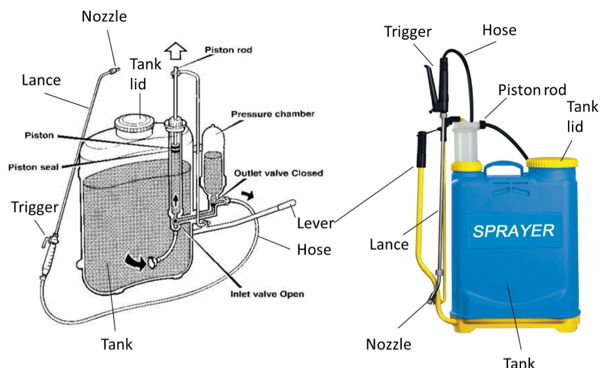
Alat semprot panggul yang umumnya digunakan adalah yang biasa disebut ‘alat semprot panggul dengan sistem tuas’ (lihat Gambar 8). Saat menggunakan alat semprot panggul, pastikan untuk mengikuti langkah-langkah berikut ini:
| Langkah 1. | Baca aturan penggunaan dengan seksama sebelum menggunakan alat. |
| Langkah 2. | Sebelum mencampur dengan herbisida, periksa kelayakan alat semprot dengan mengisinya terlebih dahulu dengan air untuk memastikan alat tersebut berfungsi layak dan tidak ada kebocoran. |
| Langkah 3. | Pilih mulut pipa (nosel) yang benar. Nosel adalah bagian dari alat dimana cairan herbisida akan disemprotkan keluar. Tipe dari nosel yang digunakan akan menentukan seberapa banyak semprotan cairan yang dikeluarkan dan seberapa luas lingkup semprotannya. |
| Langkah 4. | Kalibrasi alat semprot setiap 3 bulan sekali menggunakan air bersih dan ember. |
Menyemprotkan herbisida
Herbisida umumnya dijual dalam bentuk cairan atau bubuk. Herbisida cair umumnya dicampur dengan perbandingan 0.5, 1 atau 2 persen, yang artinya 5,10, atau 20 ml per liter air.
Always prepare herbicide solution according to the instructions on the package. Ask others for help if you are not sure how to do it. Before getting started, make sure that the sprayer is properly calibrated so that it is clear how much water comes out of the sprayer every minute.
Prepare the sprayer and do the spraying following these steps (see Figure 9):
| Step 1. | Fill the knapsack sprayer with water (e.g. 10 L). |
| Step 2. | Add the herbicide (e.g. 100 or 200 ml). Note: Always use gloves while adding the herbicide! |
| Step 3. | Close the lid and shake well. |
| Step 4. | Fill the sprayer up with more water (e.g. another 5 L) until it is full. |
| Step 5. | Spray the weeds with the herbicide solution. Per hectare it is normal to spray 50—200 L of solution (0.5 to 2 L of herbicide) depending on the number of weeds. When doing clear-weeding (not normally a good idea!) more herbicide will be needed (e.g. up to 300 L/ha). |
| Step 6. | Keep clear records of when you have sprayed, and how much. |
| Step 7. | If it rains less than 4 hours after spraying, repeat the treatment (but not if spraying Gramoxone). |
Common herbicides in oil palm
Mode of action of common herbicides
Herbicides are often divided into two groups: contact herbicides and systemic herbicides. These groups differ in their mode of action (see Figure 10). Contact herbicides are toxic to the plant where they touch it. The most well-known contact herbicide is paraquat. Systemic herbicides move into the plant and are transported to the stem, roots, and other leaves. The most well-known systemic herbicide is glyphosate. For an overview of the most common herbicides used in oil palm plantations, see Table 1. Glyphosate, paraquat and triclopyr are discussed in more detail below.
Table 1: Some contact and systemic herbicides and their common brand names
| Contact herbicides | Systemic herbicides | ||
|---|---|---|---|
| Herbicide | Brand | Herbicide | Brand |
| Paraquat Glufosinate |
Gramoxone Basta |
Glyphosate Metsulferon methyl |
RoundUp Ally |
Glyphosate 3
The most well-known trade name of glyphosate is ‘Roundup’. Glyphosate can be used to kill a wide range of weeds. It is a ‘systemic herbicide’ so it is taken up through the leaves of the weeds and transported through the plant (see Figure 10). Glyphosate becomes inactive in the soil, so it is not taken up through the roots. It is rainfast within 1–4 hours after spraying.
Glyphosate should be handled with care:
- It is slightly toxic to humans and animals
- It is harmful for the eyes
Always wear proper protective clothing including safety glasses when mixing and spraying glyphosate, and make sure all body parts apart from the head are fully covered
Glyphosate will not damage the palms unless sprayed directly onto the leaves or used carelessly and in excessive quantities
Gramoxone 4
The active ingredient of gramoxone is paraquat. Paraquat can be used to kill many different types of weeds, including grasses. It is a ‘contact herbicide’: it works through direct contact with the leaves of the weeds and is not taken up into the plant. Paraquat becomes inactive in the soil. It is rainfast within half an hour after spraying.
Paraquat should be handled with great care:
- It is highly toxic to humans and animals
- Undiluted paraquat is deadly when swallowed
- It is toxic when inhaled
- It is harmful for the eyes
- It can also irritate the skin
When mixing and spraying paraquat use full protective clothing including face mask, safety glasses and rubber gloves, and make sure that all body parts apart from the head are fully covered. Undiluted paraquat should be handled with extra care.
Paraquat will not damage the palms unless sprayed directly onto the leaves or used carelessly or in too large quantities.
Controlling woody weeds: Garlon, Release, or similar 5, 6
The active ingredient of these herbicides is triclopyr 6. The most commonly used brand in oil palm plantations is ‘Garlon’ (see Figure 12). Herbicides with triclopyr kill woody weeds and most other weeds, but not grasses such as Imperata cylindrica (alang-alang). Triclopyr is a ‘systemic herbicide’: it is taken up through the leaves or through wounds in the bark. It becomes inactive in the soil and it is rainfast within 2—4 hours after spraying.
Herbicides with triclopyr should be handled with care:
- Triclopyr is slightly toxic to humans and animals
- It is harmful for the eyes
- It can irritate the skin
- It is highly toxic to fish and should never be sprayed in or next to waterways
When mixing and spraying triclopyr always wear proper protective clothing. Make sure all body parts apart from the head are fully covered.
Triclopyr is expensive, so use it only when necessary, and with care. Triclopyr will not damage the palms unless it is sprayed directly onto the leaves or used carelessly or in excessive quantities.
References
- ↑ P. Griffee, P. Diemer, C. Chinchilla, Smallholder Oil Palm Manual, in, FAO, Rome, Italy, 2004.
- ↑ 2.0 2.1 Stewardship Community, 2008, Knapsack spraying: best practices, http://www.stewardshipcommunity.com/best-spraying-practices/knapsack-spraying/knapsack-spraying-best-practice.html, Accessed September 2013.
- ↑ ExToxNet, 1994, Glyphosate, Extension Toxicology Network, http://pmep.cce.cornell.edu/profiles/extoxnet/dienochlor-glyphosate/glyphosate-ext.html, Accessed September 2013.
- ↑ ExToxNet, 1993, Paraquat, Extension Toxicology Network, http://pmep.cce.cornell.edu/profiles/extoxnet/metiram-propoxur/paraquat-ext.html, Accessed September 2013.
- ↑ C. Cox, Herbicide factsheet: triclopyr, Journal of Pesticide Reform, 20 (2000) 12—19.
- ↑ 6.0 6.1 Dow Agro, Tips & Training: Applications, The Dow Chemical Company, http://www.dowagro.com/vm/application/applications.htm, Accessed September 2013.
Acknowledgements
The material from Storing and spraying chemicals is sourced from Smallholder Oil Palm Handbook and put together by Lotte Suzanne Woittiez (Wageningen Universit) and Haryono Sadikin, Sri Turhina, Hidayat Dani, Tri Purba Dukan, and Hans Smit (SNV) in August 2016. See Module 3: Plantation Maintenance for more information.
